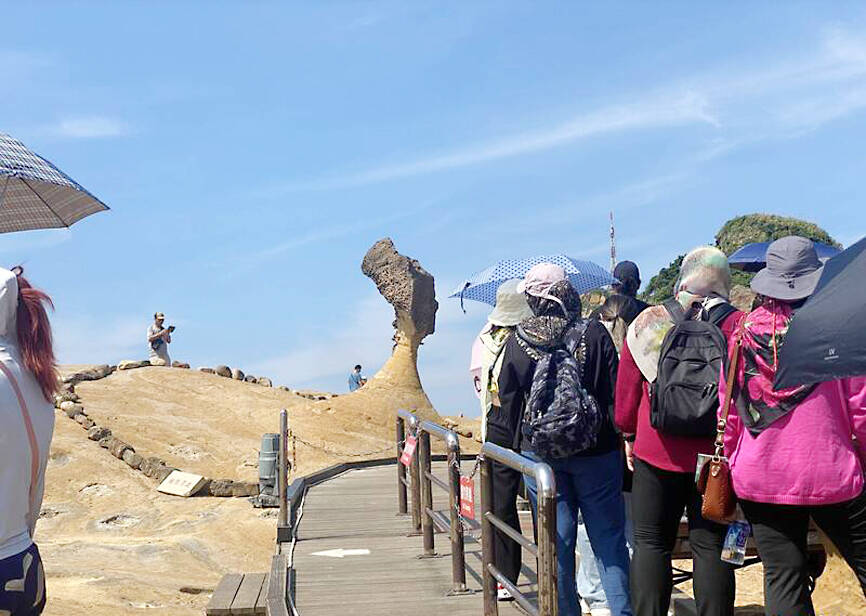The iconic Queen’s Head rock (女王頭) at Yehliu Geopark (野柳公園) in New Taipei City is under spotlight after part of the Shenao Elephant Trunk Rock (深澳象鼻岩), another famous rock formation on the nation’s northeast coast, collapsed into the sea on Saturday, due to strong waves and winds.
Rueifang District Warden Yang Sheng-min (楊勝閔) said he received a report that part of the rock formation had fallen into the sea at 1:55pm on Saturday.
As the winds and waves were really strong in the afternoon, the partial collapse was likely caused by the weather conditions, as well as long-term seawater erosion, he said.

Photo: Ting Yi, Taipei Times
The district office had set up a warning line around the area in 2020 to protect the special geographic landscape by preventing visitors from climbing onto the rock formation.
In the wake of the news on Saturday, many have expressed concern over the fate of the Queen’s Head as the circumference of the rock’s “neck” has also been diminished due to erosion and human-inflicted damage.
The pace at which the circumference of the rock’s neck is decreasing has slowed since the agency in 2012 barred tourists from touching the rock formation, the North Coast and Guanyinshan National Scenic Area Administration said yesterday.
However, there is a constant concern regarding when the neck could break due to natural erosion, it added.
North Coast and Guanyinshan National Scenic Area Administration head Chen Yu-chuan (陳煜川) said his agency has been working with a professional team researching ways to reduce the effect of erosion on the rock formation, and they are exploring high-tech approaches to preserve it.
The circumference of the rock’s neck is decreasing by 1cm to 2cm every year, the Yehliu Geopark said.
Past 3D scanning measured the circumference of the “neck” at 138.27cm in 2005, 127.88cm in 2015 and 125.01cm in 2017, it said.
The latest measurement conducted in September showed a circumference of 118.3cm, it said.

SHIPS, TRAINS AND AUTOMOBILES: The ministry has announced changes to varied transportation industries taking effect soon, with a number of effects for passengers Beginning next month, the post office is canceling signature upon delivery and written inquiry services for international registered small packets in accordance with the new policy of the Universal Postal Union, the Ministry of Transportation and Communications said yesterday. The new policy does not apply to packets that are to be delivered to China, the ministry said. Senders of international registered small packets would receive a NT$10 rebate on postage if the packets are sent from Jan. 1 to March 31, it added. The ministry said that three other policies are also scheduled to take effect next month. International cruise ship operators

NUMBERS IMBALANCE: More than 4 million Taiwanese have visited China this year, while only about half a million Chinese have visited here Beijing has yet to respond to Taiwan’s requests for negotiation over matters related to the recovery of cross-strait tourism, the Tourism Administration said yesterday. Taiwan’s tourism authority issued the statement after Chinese-language daily the China Times reported yesterday that the government’s policy of banning group tours to China does not stop Taiwanese from visiting the country. As of October, more than 4.2 million had traveled to China this year, exceeding last year. Beijing estimated the number of Taiwanese tourists in China could reach 4.5 million this year. By contrast, only 500,000 Chinese tourists are expected in Taiwan, the report said. The report

The Forestry and Nature Conservation Agency yesterday launched a gift box to market honey “certified by a Formosan black bear” in appreciation of a beekeeper’s amicable interaction with a honey-thieving bear. Beekeeper Chih Ming-chen (池明鎮) in January inspected his bee farm in Hualien County’s Jhuosi Township (卓溪) and found that more than 20 beehives had been destroyed and many hives were eaten, with bear droppings and paw prints near the destroyed hives, the agency said. Chih returned to the farm to move the remaining beehives away that evening when he encountered a Formosan black bear only 20m away, the agency said. The bear

HORROR STORIES: One victim recounted not realizing they had been stabbed and seeing people bleeding, while another recalled breaking down in tears after fleeing A man on Friday died after he tried to fight the knife-wielding suspect who went on a stabbing spree near two of Taipei’s busiest metro stations, Taipei Mayor Chiang Wan-an (蔣萬安) said. The 57-year-old man, identified by his family name, Yu (余), encountered the suspect at Exit M7 of Taipei Main Station and immediately tried to stop him, but was fatally wounded and later died, Chiang said, calling the incident “heartbreaking.” Yu’s family would receive at least NT$5 million (US$158,584) in compensation through the Taipei Rapid Transit Corp’s (TRTC) insurance coverage, he said after convening an emergency security response meeting yesterday morning. National